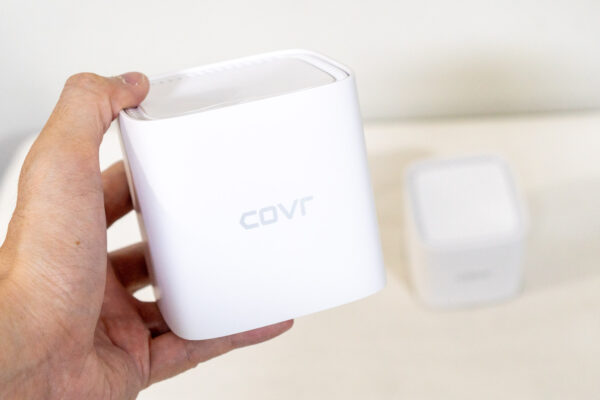
A sticky problem with most whole-home mesh network systems is that you’re usually locked into one product ecosystem. D-Link looks set to change that. Their new COVR-1100 is one of the first products to support the new EasyMesh standard that promises to interoperability with other EasyMesh-certified Wi-Fi mesh products.
D-Link isn’t new to whole-home mesh networking. I’ve reviewed many of them in this blog. The lock-in to a product ecosystem is a real problem, and it also is true of D-Link’s older products. If you want to add one more mesh node to an existing system, you’ve got to buy that same specific product. You’d already be lucky if you could use a different compatible product from the same manufacturer.
To ask for interoperability with mesh systems from other manufacturers, well, we haven’t quite seen that before. That’s what the Wi-Fi Alliance set out to address. EasyMesh brings standards-based mesh networking over multiple Wi-Fi access points, giving you the flexibility to mix-and-match EasyMesh-certified devices in your network.
The COVR-1100 is a petite cube, measuring 92 mm on all sides. Being all plastic, the unit is light. There’s a single, tiny, status LED in the centre of the top.
There are two Gigabit Ethernet ports on the back, one reserved for WAN and the other used for a LAN connection. There’s also a physical power push button, and a DC barrel jack for power.
It’s a simple device. Something I would have wished for is to have more Ethernet ports. While almost everything has Wi-Fi these days, sometimes, you’ll still need a wired connection to your NAS or game console.
The COVR-1100 is dual-band, AC1200 rated, supporting 300 Mbps on the 2.4 GHz band and up to 867 Mbps on the 5 GHz band. There is no third band for the Wi-Fi backhaul, i.e. communication between the mesh nodes. However, you can connected an Ethernet cable between the two COVR-1100 units for a dedicated backhaul connection.
There’s no Wi-Fi 6 support, the latest and fasted Wi-Fi speed. However, the COVR-1100 does support WPA3, the latest in Wi-Fi security standard. Personally, between the two, I think WPA3 is more important to have, even though most people probably are more interested in speed.
Setup is simple. Having used many other D-Link Wi-Fi products, I’m quite familiar with their app. It starts with scanning a QR code using the D-Link Wi-Fi app. After following the guided on-screen instructions, the first COVR-1100 was up and running.
If I had to complain about something, it is the amount of time the app assumes the COVR-1100 takes to reboot. The device boots up far quicker than the app thinks it does.
From then on, adding the 2nd COVR-1100 couldn’t be any simpler. It just works. I like it this way.
The COVR-1100 supports Guest Wi-Fi and simple parental control configuration in the mobile app. By simple, I mean, you can only just set Wi-Fi access times for selected devices. This will likely fall short of many parent’s expectations.
There are more features in the COVR-1100, but you can only configure them through the web-based interface. This includes simple website URL filtering, firewall control, port forwarding, and QoS configuration.
You can’t configure the 2.4 GHz band separately from the 5 GHz, in case this is something you’re looking out for.
I’ll describe the COVR-1100 as meeting basic home Wi-Fi needs. It’s easy to setup, but don’t expect many advanced features.
Interestingly, the COVR-1100 does support bridged mode operation. This is where the mesh operates as a bridge, and thus act as an extension to an existing broadband router. This can be useful for advanced users who want to attach a mesh Wi-Fi system to an existing router which they still want to use.
Performance of the COVR-1100 was a little middling. My speed tests in a somewhat ideal condition managed to clock about 220 Mbps. This is more than sufficient for all types of casual uses, including multiple video streaming sessions.
With the 2-pack bundle, the COVR-1100 is supposed to cover 325 sqm of space, which should be good enough for most apartments. EasyMesh is nice, but given the COVR-1100’s affordable price point, you might want to simply add more COVR-1100 units than to find other Eash-Mesh certified devices which are, unfortunately, not common at this time.
Integration with Google Assistant and Alexa is a nice bonus. It’s mostly gimmicky though. I setup it up with my Google Home, and I can give voice commands to do things like enabling or disabling my Guest Wi-Fi, or rebooting the router. Nice to wow the guests, I suppose.
The D-Link COVR-1100 2-pack bundle includes two power adapters and one LAN cable. It retails at S$159 (street prices are lower), and it is available from online stores like Hachi.tech, Lazada, and Shopee.
Summary
D-Link’s new COVR-1100 mesh system is easy to setup, and its support for the EasyMesh standard makes it easy to interoperate with other EasyMesh-certified mesh systems from other manufacturers.
Pros:
- Simple to setup
- Supports EasyMesh standard
- WPA3 security
Cons:
- No Wi-Fi 6
- Middling speed
